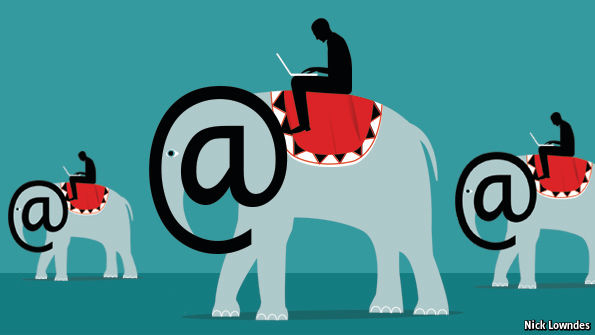Don’t p@nic
Punctuation has rarely been truly stable

INTHEBEGINNINGWASTHEWORD, and the word was run together. Ancient
texts (like the Greek of the Gospel of John) had few of the devices that
tell readers where words begin and end (spaces), which words are proper
names (the upper-lower case distinction), where breaks in meaning come
(commas, dashes, semicolons and full stops), who said what (inverted
commas), and so on.
Most people take punctuation to be something obvious and settled. In
fact, the system is in a bit of upheaval. The beginnings of that date
back to 1971, when Ray Tomlinson sent an experimental message between
two computers in the same room, connected only by ARPANET (the precursor
to the internet).
Tomlinson, who died on March 5th, made a lasting contribution to the
world’s orthography by choosing the @ symbol for e-mail addresses. His
legacy will be a long one. E-mail and the @ sign have conquered the
world: you cannot truly say you speak a foreign language until you can
give your e-mail address complete with the local word for the glyph,
like snabel-a (“elephant-trunk A”) in Danish or aapenstartje (“little monkey’s tail”) in Dutch.
Other innovations may have seen their day come and go: nerds once
preferred tags in the style of HTML (used to code web pages) like
“<sarcasm>”. But this already seems to be on the wane, in favour
of things like “*sigh*”. A *sigh* was Johnson’s reaction to another
story of non-traditional writing: last year Oxford Dictionaries chose an
emoji—those cartoonish faces descended from emoticons—as its “Word of
the Year”. (It was the face intended to signal “tears of joy”.) Emoji
aren’t really words or punctuation, but something akin to a graphical
hashtag, performing a bit of the same role as tone of voice and body
language in speech.
With all this flux, many people worry that skill with punctuation is
disappearing: witness, after all, the way teens text and tweet not
bothering to capitalise or punctuate at all. It is in fact more
complicated (and interesting) than that. Not putting a full stop in a
text is normal for teens in an internet message, and including it sends a
separate note of annoyance or frustration on the part of the writer.
Full stops can also be used for other effects, like “You. Must. Be.
Joking.”
Such chaos is not all that historically unusual. The first English
writers, when they punctuated at all, availed themselves of
long-forgotten symbols like the diastole and trigon, the interpunct and
the diple. Printing began the process of settling the punctuation
system, but even that took four centuries. Samuel Johnson’s commas, in
the mid-18th century, were not only heavy; many would be ungrammatical
today, and this style persisted into the first editions of The Economist in 1843.
As David Crystal, a linguist, points out in his history of
punctuation (“Making a Point”) published in 2015, at the dawn of the
19th century, punctuation prescribers were still divided into those who
insisted that punctuation follow grammar and those who wanted it to aid
elocution. Even one of the grammarians, Lindley Murray, wrote in 1795,
in a hugely influential grammar book, that a semicolon signalled a pause
twice as long as a comma; that a colon was twice as long as a
semicolon; and that a full stop was twice as long as a colon. (Try that
next time you read a text aloud.)
Punctuation, in other words, has not always been the epitome of order
that some of its fans think. It is unsurprising that the rise of
computers would unsettle a system that had barely settled to begin with.
Fortunately, most of the upheaval is confined to new channels: e-mail,
texting, Twitter and whatever is to come next. Even most teens know to
keep it out of formal writing. And those who prefer not to follow fads
at all need only wait a while: much of today’s playful punctuation will
soon become unfashionable, dead as the diastole and the diple.


តើខ្មែរយើង គួរហៅសញ្ញា @ ហ្នឹងថាយ៉ាងម៉េច ?
ReplyDeleteខ្ញុំ គយគន់វា ប្រហែល៣នាទី ឃើញមានរាងដូច យ គ្រវាត់ គឺ យ្រ,ហើយ
ជួនកាលទៀតដូច ឯ្រ, ខ្ញុំគិតថា ខ្មែរយើងគួរហៅ សញ្ញានេះថា រយ៉ែ !!!
តែបើចង់ពីរោះ គួរហៅថា ភ្នែកអូន !!!